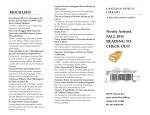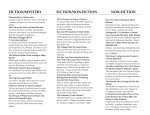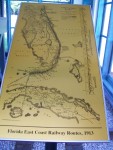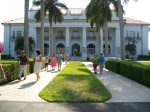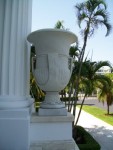Archive for the ‘Non-fiction’ Category
New reading at the Library this fall 2015
Hi everyone…We’ve some great new reading for you this fall 2015! Please come to the Library to check them out. Some of these you won’t find easily at other libraries around here.
An overview of some of them can be seen here: Publication FALL 2015 reads
We also have new books in history, business, and social sciences.
To search for a book, see our new KOHA on-line catalog at http://lantana.bywatersolutions.com/
The Personalized Internet and the Big Brother Internet
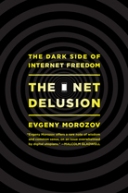 The Filter Bubble:
The Filter Bubble: 
What the internet is hiding from you
By Eli Pariser
[Hardcover], 293 pages
Call No.: 004.67 Par
The Net Delusion: The Dark Side Of Internet Freedom
By Evgeny Morozov
[Hardcover], 432 pages
Call No.: 303.4834 Mor
Eli Pariser is a well known activist and a founder of Moveon.org, a liberal leftwing political action committee (PAC). In The Filter Bubble: What the Internet is Hiding from You, Pariser briefly explains how he became aware of the “invisible algorithmic editing” and filtering of his personal search results using Google and his Facebook newsfeed. How will such editing, filtering, and personalization likely hinder what we as informed people need to see, Pariser asks. Are we, the users, even aware of how our “information diets” are not balanced but instead are based on our own keystrokes and wants, tracked by the internet, and fed back to us? Pariser claims we largely aren’t.
I had never understood how personalized search results are actually based on induction — on many of our previous searches, as well as a multitude of other factors, including our IP addresses/locations, of course.
Watch Pariser’s TED Talk in March of 2011 to promote his book and then check the book out at Lantana Public Library. Evgeny Morozov also writes a thoughtful review of Pariser’s book, as well, titled “Your Facts,” on the New York Times website, June 10, 2011.
Morozov’s The Net Delusion: The Dark Side Of Internet Freedom analyzes internet freedom in recent history and criticizes recent political attempts to reinvent it as a new form of the Cold War.
Morozov criticizes the Western media’s claims that Twitter, along with widely available gadgets and internet connectivity and foreign support, helped to coordinate the Iranian June 2009 election protests by the Green Movement. Citing credible sources, Morozov reveals that U.S. State Department requests to Twitter to delay its scheduled maintenance of its website minimally helped the protests; Iran had proportionately fewer Twitter users actually in Iran, and Twitter feeds were probably not needed to inform Tehran residents of street protests.
Indeed, Morozov is critical of the Google Doctrine – best expressed by Secretary of State Hilary Clinton in January 2010 as the optimism that internet freedom is essential to fighting authoritarian governments. Morozov observes that the three activities of Orwellian-style authoritarianism – propaganda, censorship, and surveillance – are not ultimately overturned by the 24 hour information news cycle, social networking, or the high speeds offered by internet. Undemocratic governments persist, not rendered illegitimate either: extreme nationalism, economic prosperity, and other developments may used by such governments to rationalize their actions.
Morozov isn’t entirely pessimistic, however. He prescribes cyberrealism, in the form of decentralized regional policies, non-technological solutions to political problems, and recognition that the internet doesn’t automatically bring democracy.
These are must-reads for anyone who wants to understand other perspectives on the internet!
New: On Thin Ice: The Changing World of the Polar Bear by Richard Ellis
 On Thin Ice: The Changing World of the Polar Bear by Richard Ellis
On Thin Ice: The Changing World of the Polar Bear by Richard Ellis
[Hardcover] 403 pages
Borzoi/Alfred A . Knopf, 2009
ISBN No. 978-0-307-27059-7
Lantana Public Library Call No. 599.74446
Richard Ellis is a well-known marine conservationist, writer, and nature artist who is fascinated by our contradictory relationships with endangered wildlife, marine in particular – whether with fascination and fear or love and hate, or to save and destroy. I was familiar with iconic artwork, including his beautiful mural at the New Bedford Whaling Museum in Massachusetts.
Ellis’s motivation for On Thin Ice about polar bears is that they represent both our veneration for wildlife and disrespect for nature and in particular the polar bear’s Arctic environment, under siege from global warming and melting ice. He quotes American naturalist Henry Beston, who claimed animals not “as brethren, underlings, but as other nations, caught with ourselves in the net of life and time…”
Ellis begins with personal encounters of his own with polar bears (Ursus maritimus, the marine bear) and recounts historical encounters of early Europeans and also modern polar explorers with the bears (who have primarily been hunted or simply killed for no reason).
He also relays less-known information on its curious morphology (such as its extraordinary abilities to smell through 2 feet of ice from miles away, to fast for up to 8 months of the year, unlike other bears, and also to delay pregnancy), diet (almost entirely of ringed seal), behavior (ranging from remarkably playful, calm and curious to aggressive, threatening, and dangerous).
Ellis also outlines polar bears’ circumpolar population distributions (somewhere between 20,000 to 30,000) and variable life chances in several countries where they are found today – also interesting to learn of. His chapters on the bears alongside Eskimos, inside traveling circuses and zoos, and on its status (we love and fear its whiteness, shape, and the cuteness of the cubs such as Knut in the Berlin Zoo), both sadden and fire our imaginations.
Over the years I’ve seen polar bears in city zoos, invariably shuffling about or swimming. I also remember Norbert Rosing’s famous photos of a wild polar bear in Churchill, Canada, who for a week came every night to play with a sled dog.
Another of Ellis’s other recent written works, also available at Lantana Public Library, is Tuna: A Love Story, a well-received bio-history on the tuna fish and its future. It’s a good read for anyone interested in better understanding the fish, our insatiable love of eating it, and the global fishing industry that endangers its existence. (Also, read the June 2008 Scientific American article available on-line.)
New: The Last Resort by Douglas Rogers
 The Last Resort: A Memoir of Mischief and Mayhem on a Family Farm in Africa
The Last Resort: A Memoir of Mischief and Mayhem on a Family Farm in Africa
by Douglas Rogers
ISBN: 978-0-307-40798-6
[Paperback] 317 pages
Lantana Library Call No. 968.91 Rog
Hi to Lantana!
What do we think of when we hear the expression “the last resort” ? Is it
*A last choice or ditch effort, an expedient solution tried if all else fails?
*A place of aid and refuge?
*A popular, luxurious place to visit?
*An incredible course of action — say, a last stand or final opportunity of appeal?
Obviously it means all of the above. One of its more obscure meanings, though, is a reversion to a former state, condition or habit, whether good or bad or in between. All of these meanings, and especially the last, kept me reading Douglas Rogers’ The Last Resort, a memoir of his aging parents and their survival in their long declining and failing country and homeland, Zimbabwe.
From the novel’s opening, readers realize a kind of “line in the sand” has been drawn by Rogers’ parents. They make plans to hang on to their home (a game farm and lodge named Drifters) in ways that neither they nor we the readers know to expect, as hard as they and we the readers try to determine and guess.
Once the foreign tourists stop arriving in the wake of continued white commercial farm invasions by the government and the sponsored war veterans and militas, as well as the national, social, economic, and political upheavals that erupt, Rogers’ parents Lyn and Rosalind and their plans shift into gear, changing strategies — first to accommodate displaced local white farmers and then fugitive opposition MDC party activists. All the while, they cope with ordinary every day demands for food, fuel, electricity, communication, security, and news, among other things. Yet, they live for the pleasures too of their neighbors’ crops and returned livestock, sports, braais, marriages, births, and the fortunes of family, friends, neighbors, employees and partners. Drifters even becomes for a time a brothel to serve, among others, groups of corrupt and powerful local ruling party politicians, and it becomes a popular watering hole for illicit diamond dealers.
As rule of law wanes, then, ordinary people, Rogers’ parents included, prove to be extraordinarily resilient, creative, courageous, and perversely wise. Their story and those of others are all recounted by Rogers most often in a humorously moving, compassionate, and yet disarmingly honest manner.
Many Americans by now know of the tragedy of Zimbabwe and particularly of the tryanny of Robert Mugabe and his ZANU-PF ruling party. Rogers’ cast of characters and the bizarre course of events on his parents’ farm and lodge resound with much of the darkly cynical and disgustingly brutal stories known to many of us who’ve followed the news.
And yet, the characters and their stories are strangely funny and refreshingly memorable as well. The patience, tenacity, and of Rogers’ parents and their community of friends and neighbors revert to and call upon are unshakeable and unmistakable. They all find ways to survive and even thrive in a country where formal economic activities, lawful property ownership, and local currency have all precipitously fallen away (for instance, Zimbabwean inflation as recently as 2008, running in the millions). My comments here all the beg the question. Zimbabweans in Zimbabwe may still live varied, full, rich lives that outsiders cannot always see.
Readers can compare Rogers’ work alongside other Zimbabwean memoirs to emerge in recent years — and there have been many — including Alexandra Fuller’s Don’t Let’s Go Down to the Dogs (Tonight), Peter Godwin’s Mukiwa and When a Crocodile Eats the Sun, Jill Baker’s Beloved African, Geoff Nyarota’s Against the Grain, and Angus Shaw’s Kandaya: another time, another place — to name only a few! On the web, there are the posts of Cathy Buckle and her writing. Rogers’ memoir, however, is somewhat unusual, for as he returns to visit his parents and Drifters, he discovers the home of his childhood in the manner of a traveller. (There is even now a filmed documentary of the Drifters currently in production.)
On a personal note: more than any other work on Zimbabwe in recent years, Douglas Rogers makes me wish to return there to visit, and to shed some of the curiously displaced, in-exile mindset I’ve always had as a child born of diplomats. I look to gain another mindset, not of my childhood, but somehow a more re-connected one with my past life. (For my parents, siblings and I, as well as in-laws, have watched Zimbabwe from a far for years, having made our home there and in neighboring countries of the region for so long (from 1971—2008); we remember all too well what was and what has happened in recent years there.) I do wonder if Zimbabwean friends of mine on Facebook, some of them now citizens or residents of other countries, and others still home in Zim, to some degree feel some disconnect or separation as I do.
I think Zimbabwe poet Chenjerai Hove in his Poem for Zimbabwe (in his work, Blind Moon) profoundly expresses some of what I wish for: “but with time you will hear your voice in the blue skies of my heart.”
Zimbabwe, and my few friends there, alive and gone, in touch or out of touch, still stay with me, and maybe I with them, here in South Florida.
Reading in times of distraction…
 The Lost Art of Reading:
The Lost Art of Reading:
Why Books Matter in a Distracted Time
by David L. Ulin
ISBN-13: 978-1-57061-670-9 [Hardcover],
Sasquatch Books, 2010, 152 pages
Lantana Library Call No. 028.9 Uli
Good readers of Lantana! Do not disregard a desire to read books, yes books, even if you feel embarrassment or disquiet that you read books far less now than you did ten to twenty years ago. David Ulin, LA Times book critic, may have some insights for you.
Picking up Ulin’s slight, hand-sized last month, I intended to speedily read it as if for sport. Distractions of all other kinds won out, just as they did Ulin. I picked it up again, though, and on arriving at page 9, found Ulin confessing that,
Sometime in the last few years—I don’t remember when, exactly—I noticed I was having trouble sitting down to read. That’s a problem if you read, as I do, for a living, but it’s an even bigger problem if you read as a way of life.
That resonated with me, as I’m a teacher, a librarian by educational background, and a reader for enjoyment, too. I also like Ulin’s insight that reading is really a journey of discovery, an excavation of our inner world, even if it doesn’t seem to be ours (the readers’) at the beginning. Ulin observes it’s important to “take the plunge” and to remember that the writing we read is a kind of interaction. A sort of give and take, perhaps, a push-pull relationship, a lurking played out in silent intimacy? Hmmm-hmm.
Ulin sets forth the sources of his distraction (much of which will be familiar to you as it is to me — internet, the 24 hour news steam, etc.). Then he narrates, albeit meandering at times, a personal essay of how reading can be rediscovered. He seeks to help his technology-savvy teenage son enjoy Fitzgerald’s The Great Gatsby. His son in turn helps Ulin recognize a kind of interactivity and connectivity in the on-line chatting, lurking, browsing, and scanning of search engine results, websites, Facebook posts, e-mails, and e-readers.
Beyond that, though, Ulin is able to rediscover the pleasures of reckoning with time and slow, long form reading, for he claims that what we read inhabits us and we animate it in turn. He also enlists the help of Fitzgerald, Thomas Paine’s Common Sense, and a host of other modern writers and thinkers to help him (and us) rediscover reading for pleasure.
Health: Free Breast/Mammogram Screenings in Palm Beach County
Breast Cancer Awareness month is October. Palm Beach County has a number of events this month and beyond to help fundraise, educate, and inform women about procedures, costs, and locations.
Had you heard of a program for uninsured and lower income women to obtain free breast/mammogram screenings?
If you are in need of a screening, are uninsured or underinsured, and can drive to Boca Raton, please call the following number (at Boca Raton Regional Hospital) for more information on scheduling an appointment and obtaining a Komen Grant: ( 561)955-4294
My screening/mammogram is being made available through the Kathryn Krickstein Pressel MammoVan, which operates with Boca Raton Regional Hospital.
Boca Raton Regional Hospital is a current recipient of grants awarded to non-profit health care agencies and service providers in our area via the County’s own chapter of the Susan G. Komen Foundation/For the Cure® .
Komen Grants are available/renwable year after year.
Click here for a longer list of health care agencies in our area that have received Komen grants. You can also phone 561-514-3020 x14 or email lisa@komensouthflorida.org for more information.
Here are some helpful resources/books in our library on breast cancer:
*Living through breast cancer : what a Harvard doctor and survivor wants you to know about getting the best care while preserving your self-image by Carolyn M.Kaelin
(Lantana Library Call No. 616.994 Kae)
*The American breast cancer guide : a comprehensive resource directory.
(Lantana Library Call No. 616.994 Ame)
*The everything health guide to living with breast cancer : an accessible and comprehensive resource for women by Lucia Giuggio Carvalho.
(Lantana Library Call No. 616.994 Car)
*Straight talk about breast cancer : from diagnosis to recovery by Suzanne W. Braddock
(Lantana Library Call No. 616.994 Bra)
An update on some of wonderful things that will soon be in our future…
The Physics of the Future: How Science will Shape Human Destiny
and Our Daily Lives by the year 2100.
By Michio Kaku
ISBN: 978—0385-53080-4
[Hardcover] New York: Doubleday
393 pages
Have you heard of any of the following inventions that are all likely to appear within this century, thanks to successful scientific advances in computing and micro chip technology, which have already created their prototypes?
Internet glasses and contact lenses;
driverless cars;
four wall screens;
real and virtual reality mixed;
universal translators,
fMRI mind readers;
tricorders (like in Star Trek) and portable brain scans;
and last but not least, photographing our dreams!?
Michio Kaku, the famous MIT physicist, author, and co-founder of String Field Theory, opens his new book with discussion of these incredible developments. Subsequent chapters focus on different scientific efforts, including Artificial Intelligence/Robotics, the future of medicine, nanotechnology, the futures of energy and space travel, and even of wealth.
Some of these areas seem to be advancing more quickly than others, I was surprised discover. Artificial Intelligence and Robots, for example, are familiar to all of us, yet they are still not able to match the human brain in intelligence and consciousness. Other areas, such as Nanotechnology, are rapidly growing. (Nanotechnology is the ability to manipulate subatomic/molecular particles for all kinds of purposes, such as transistors, computing, chemical coatings, and even nanocars and particles to fight diseases in our bodies. See a picture of the world’s smallest nano guitar, created by Professor Dustin Carr).
What is compelling about these developments is Kaku’s uncanny observation – “that it is very dangerous to bet against the future.” He correctly recognizes the historically we have consistently underestimated the power of scientific technology. He also correctly notes that each time one of the four fundamental laws of nature was discovered, it forever changed human history – these are Newton’s laws of gravity, electricity (electromagnetic forces), atomic/nuclear fission, and quantum/subatomic physics.
However, Kaku also brings to our attention the issue of when such exponential developments and remarkable revolutions will end, particularly in computing. Computing power is said to have doubled every 18 months over the last 50 years, according to Gordon Moore, one of the founders of the Intel Corporation. Kaku argues ominously, however, that eventually Moore’s Law will fail; by mid century it will become increasingly difficult (if not physically impossible) to etch more miniaturized transistors onto silicon computer chips, which drive the computing revolution. At some point, silicon-based computing will reach its limits.
I’m just getting ready to read the section on our energy future, which promises to be the most interesting of all.
I admit that at this point I’m not as optimistic about the future as I used to be. However, this book is utterly fascinating to read and Kaku’s enthusiasm, tone, and intelligence, curiosity, and humaneness all make me reflect and remember that possibility remains with us.
Hurricane info and reads to weather the season in South Florida
In the wake of Hurricane Irene’s intrusions and recent landfalls here along the Atlantic coast, I’ve been reading more on Florida hurricane history, as well as using some of the local resources to help my family and I remain prepared in storm season. I thought I’d share them with you.
*Florida State University’s Information Institute Hurricane Preparedness and Response Portal
Did you know that Florida public libraries have served as important centers for emergency information and assistance after hurricanes? This portal has planning guides, evacuee assistance information, a searchable database with many resources, and updates:
http://hurricanes.ii.fsu.edu/
*Fox 29 (WFLX)’s Hurricane Center
An excellent resource with local tracking maps and plots (continously updated with feeds from the NOAA) was recommended to me by a colleague at work recently. (Users can also find it on-line via any search engine by typing in “WFLX hurricane center,” or by clicking on the link below):
http://www.wflx.com/category/39089/hurricane-center
http://www.wflx.com/link/491253/hurricane-tracker
*National Hurricane Center
The NOAA/National Weather Service’s website — including forecasts and advisories. Also has maps of wind speed probability an also mariner advisories.
http://www.nhc.noaa.gov/
*211 for Palm Beach/Treasure Coast
Phone Numbers: 2-1-1 (from service area) (Dial 2-1-1 for TTY/TDD Access)
(866) 882-2991 (Alternative Number)
(561) 383-1111 (Alternative Number)
http://www.211palmbeach.org/
__________________________________
Lantana Public Library also has a large collection of books on hurricane history, and hurricanes in general, including materials for children. Here’s a sampling of them.
General history, science, and forecasting
Divine wind : the history and science of hurricanes
By Kerry Emmanuel
Call No.: 551.552 Ema
Hurricane watch : forecasting the deadliest storms on earth
By Dr. Bob Sheets and Jack Williams
Call No.: 551.552 She
Hurricane force : in the path of America’s deadlist storms
By Joseph B. Treaster
Call No.: 551.552 Tre
Florida Hurricanes
Florida hurricanes and tropical storms
By John M. Williams and Iver W. Duedall
Call No.: Fla 551.552 Wil
Killer ‘cane : the deadly hurricane of 1928
By Robert Mykle
Fla 975.939 Myk
Okeechobee hurricane and the Hoover Dike
By Lawrence E. Will
Call No.: Fla/Ref 975.939 Wil
Stormscaping : landscaping to minimize wind damage in Florida
By Pamela Crawford
Call No.: 635.952 Cra
Tropical surge : a history of ambition and disaster on the Florida shore
By Benjamin Reilly
Call No.: Fla 975.9381 Rei
Katrina
Breach of faith : Hurricane Katrina and the near death of a great American city By Jed Horne
Call No.: 976.335 Hor
Zeitoun
By Dave Eggers
Call No.: 976.335 Egg
For Children
Hurricane!
By Jonathan London and Henri Sorenson
Call No.: C E Lon (Children’s section Fiction)
Anatomy of a hurricane
By Terri Dougherty
Call No: C 551.552 Dou (Children’s section/Non-fiction)
Available: The Brain that Changes Itself by Norman Doidge
 The Brain that Changes Itself
The Brain that Changes Itself
by Norman Doidge
Lantana Library Call No.: 612 82 Doi
When Dr. Doidge, an M.D. and psychiatrist, first noticed that some patients responded to treatment in ways that indicated that their brains were not hardwired and that brain damage might be undone, he didn’t believe it. Research led him to the relatively new science of neuroplasticity, which appears to allow a damaged brain to reconstruct itself. This is gripping stuff, and you do not have to be a doctor to understand it: It is also a pleasure to read, and the case histories give room for hope.
(From the Short List, March 11, 2009, by Catharine Rambeau)
Founder’s Day at the Flagler Museum…
When I saw the Palm Beach Post ad about free admission on Sunday, June 6, 2011, to the Flagler Museum in Palm Beach, I couldn’t resist and drove on up there. It turned out to be Founder’s Day, in honor of the museum’s founder Jean Flagler Matthews.
I hadn’t been to the Museum in years, and it was well worth the visit. I lingered around the entrance of the original Whitehall building, designed by John Carrère and Thomas Hastings, with its neo-classical columns, urns, and bronze doors, and then also inside its front hall, with its Apollo fresco. Not only did I get to see artwork and furnishings of the Gilded Age: This time I was also able to enjoy a new pavillion built in 2002 behind the main museum to house Flagler’s famous private rail car. As you can see above, this new pavillion is reminiscent of an early 20th century train station. I especially loved its Tiffany clock at the entrance and the map of Flagler’s rail and ferry empire, which extended from Florida to Cuba.
Just as an FYI — Lantana Public Library has two excellent works on Henry Flagler:
Henry Flagler : visionary of the Gilded Age, by Sidney Walter Martin
(Library Call No. Fla B Fla), and
Last train to paradise: Henry Flagler and the spectacular rise and fall of the railroad that crossed an ocean, by Les Standiford (Call No. Fla 385 Sta).
